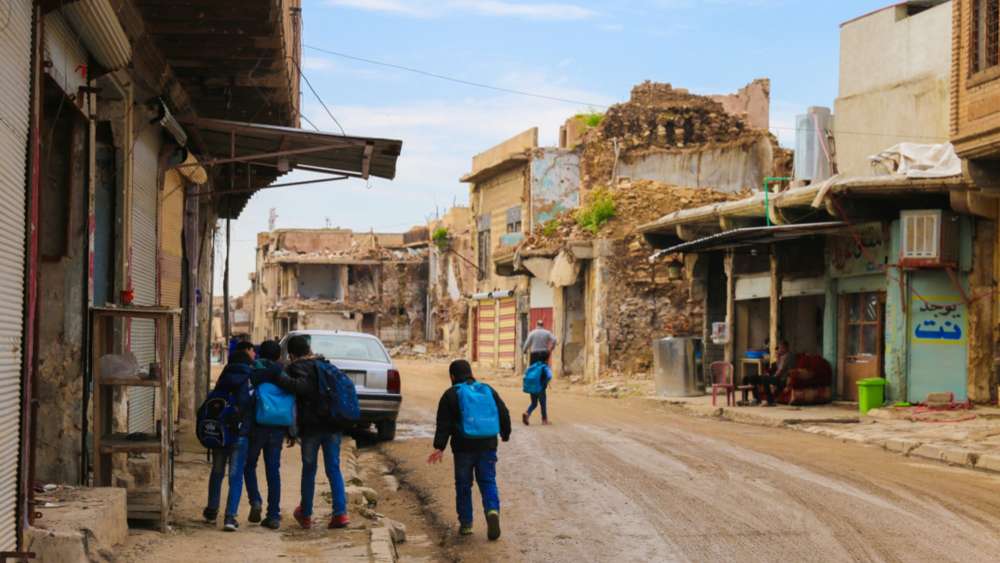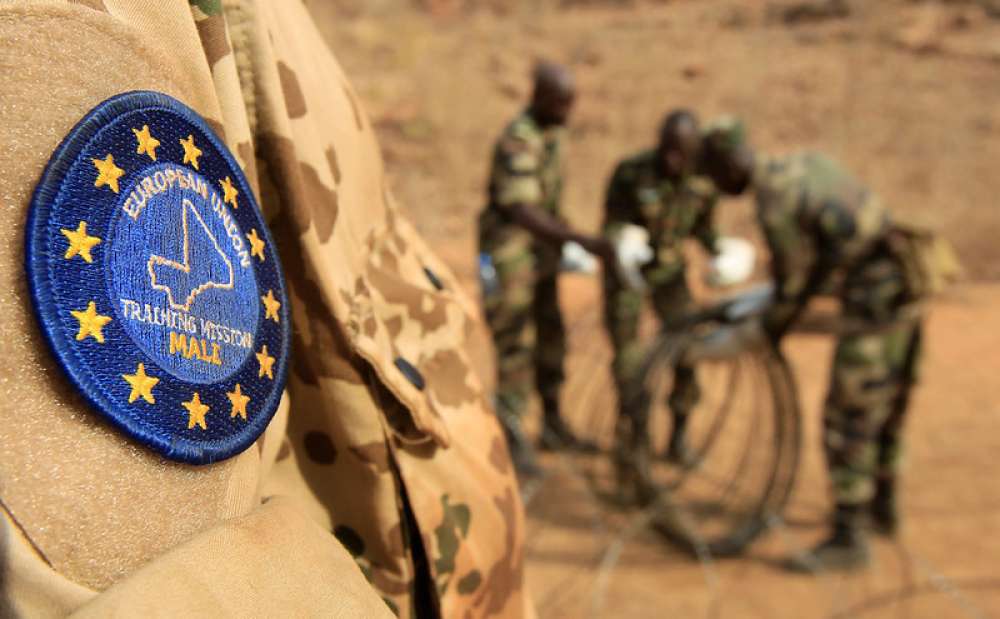Prioritizing the Protection of Civilians in National Security

(Photographer RM /Shutterstock)
When drafting security policy, those most affected by conflict are often missing from the equation. Applying a protection lens to Germany’s upcoming security strategy would be a way of putting civilians first.
It is, by now, a well-worn cliché to call Russia’s invasion of Ukraine in February 2022 a watershed moment for the European and international security architecture. As German policymakers draft the country’s first integrated national security strategy, they are doing so against the backdrop of major combat operations in Europe, a worldwide food crisis and a displacement – internal or external – of over 15 million people. The war in Ukraine has also prompted an increase in defense spending among NATO members: in Germany alone, a special fund of €100 billion will top up the existing defense budget between 2022 and 2030. For some, this exemplifies Germany’s move away from a security policy that prioritized conflict resolution through non-military means, promoted trade as a means of transforming international relations (‘Wandel durch Handel’) and focused on development aid. Others have welcomed Berlin’s investment in defense as proof of a long-overdue recognition of the new reality.
What is missing in these increasingly polarized debates on military versus civilian means is a recognition of the need to anticipate and to better protect civilians from the effects that war will have on them. Wars disproportionately impact civilians: the UN estimates that 100 non-combatants die in conflicts every day. Between 2001 and 2021, 387,000 civilians are thought to have died in major conflicts, and many more suffered due to the destruction of critical infrastructure. During the 9 months of war in Ukraine alone, over 15,000 civilians were killed or injured, 6.5 million people were internally displaced and 7.7 million became refugees. The use of explosive weapons in populated areas, targeting of critical civilian infrastructure and a lack of provisions for evacuations continues to put civilians in Ukraine at risk.
» Needs related to the protection of civilians reach across humanitarian, civilian and military considerations and should shape not only civil preparedness and resilience, but also defense policy and military procurement. «
Protecting civilians in conflict – including mitigating harm caused by one’s own operations, protecting against harm brought about through the actions of others and supporting civilians’ own approaches to protecting themselves and their communities — is a moral, legal and strategic imperative with a basis in international humanitarian and human rights law. Protecting civilians can lessen the cost of war through limiting the number of victims, reducing trauma, preventing continuing cycles of grievances, and laying the foundation for long-term peacebuilding. Because of its importance, the ability to protect can be seen as a key lens through which to organize and implement a national security strategy. Needs related to the protection of civilians reach across humanitarian, civilian and military considerations and should shape not only civil preparedness and resilience, but also defense policy and military procurement. This applies to both preparedness at home and expeditionary crisis management and peace support operations.
Protection in Peace Support Operations and Defence Capacity Building
Peace support operations mandated and carried out by the United Nations increasingly find themselves protecting civilians where they operate, especially when national authorities are either incapable or unwilling to do so. To play an effective protection role, the missions need specific, clear mandates to protect, the assistance of the host government, training that enables them to understand protection needs, and equipment to keep themselves and others safe.
MINUSMA, currently the Bundeswehr’s largest overseas deployment, is one example of a mission that has struggled to tame the increasing violence toward civilians in its area of operations. To protect civilians, MINUSMA put in place an early warning and rapid response system, amended operating procedures to allow troops to be stationed outside of large bases and enabled decision-making at a lower, tactical level. However, while research suggests that these adaptations indeed helped to protect civilians, the mission has struggled with a limited availability of critical equipment, particularly air assets. Shortage of ISR platforms, transport helicopters and casualty evacuation assets limited MINUSMA’s ability to understand the situation on the ground, respond to signals of impending danger and assist civilians who had been wounded.
Key Points:
- Protecting civilians in conflict is a strategic imperative that can lessen the overall costs of war.
- To put civilians first, Germany’s security strategy should ensure that peace support operations have the right capabilities to fulfil their protection mandate.
- Germany should take the lead to craft a shared protection approach among NATO nations.
While having the consent and support of host governments is crucial to missions’ effectiveness in protecting civilians, the MINUSMA example also suggests that having the right capabilities is indispensable to fulfilling a protection mandate. A protection lens provides useful guidance for allocating resources and prioritizing procurement, leading to a focus on assets and training that can directly contribute to better outcomes for civilians. This could include intelligence and reconnaissance equipment, casualty evacuation assets and training in civil-military cooperation and community engagement that would position armed forces to effectively respond to protection threats.
Protecting at Home: the Danger of Escalation
The resurgence of war in Europe has brought to the forefront questions of how to best protect civilians in NATO nations against an array of threats, from hybrid warfare to kinetic operations in urban centers. Following Russia’s full-scale attack on Ukraine, NATO significantly reinforced its presence in the East, doubling the number of Enhanced Forward Presence battlegroups and scaling them up to brigade size. However, the increasing attention accorded to the changes in military posture does not seem to have been matched by an analysis of civilian protection threats and responses. While NATO has developed Protection of Civilian (PoC) approaches through its expeditionary operations – it implemented civilian harm mitigation approaches in Afghanistan and has adopted a PoC policy, military concept, directive, and handbook – it is not clear whether these approaches have been adapted to enhance preparedness at home, or that individual Allies’ approaches to protection are similar enough to allow for seamless cooperation.
» A shared approach to the protection of civilians is key to effective preparedness. «
Given the number of nations present on NATO’s eastern flank, a shared approach to the protection of civilians is key to effective preparedness. An effective PoC approach should include an understanding of likely self-protection responses from civilians in the event of an escalation, strong links with the host population and the ability to support their approaches to preserving resilience, a good awareness of critical infrastructure that includes dual-use installations, the deployment of military and civilian assets to enable better protection outcomes (such as intelligence and air defense assets), and an ability to offer comprehensive training to multi-national NATO units. Since Germany already plays a key role in NATO deployments in Lithuania, Berlin should take the lead in facilitating the implementation of a common protection approach among NATO nations.
Constructing and implementing a national security strategy through a protection lens would enable German policymakers to design a spectrum of capabilities and approaches that put civilians first, thereby mitigating harm from their own operations and lessening the impact of others’ actions. Shared, robust protection approaches require time and resources to develop and implement, as they need to be systematically integrated into operational planning cycles and rules of engagements to effectively protect civilians when hostilities start. In light of current conflict trends, protection of civilians is a critical capability set that would benefit not only Germany’s armed forces and government departments, but also NATO, EU and UN operations to which Germany might contribute.
Karolina MacLachlan
Senior Advisor, Policy and Advocacy, Center for Civilians in Conflict (CIVIC)
Keep on reading

National Security Means Addressing the Climate Crisis
When it comes to national security, the climate crisis is just as – if not more – threatening than traditional concerns like conflict and war. How can Germany embrace climate action?

Demokratie muss zu einem Kerninteresse deutscher Außenpolitik werden
Das Thema Demokratie zieht sich wie ein roter Faden durch die großen Herausforderungen für deutsche Außenpolitik. Die Strukturen des Auswärtigen Amtes spiegeln das nicht wider. Höchste Zeit, das zu ändern.

“The Issue of Good Governance has Become Too Marginalized in German Security Assistance”
Germany has shifted its approach to stabilization in the Sahel, from peacebuilding to a stronger emphasis on militarization. The results have been disappointing, says Olivier Guiryanan. Why Berlin should adjust course – and how.